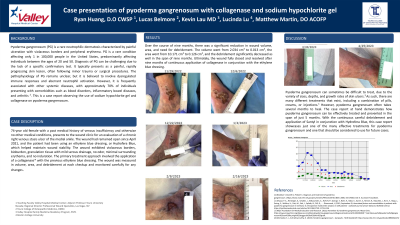Case Series/Study
(CS-073) Case Presentation of Pydomera Gangrenosum with Collagenase and Sodium Hypochlorite Gel

Pyoderma gangrenosum (PG) is a rare neutrophilic dermatosis characterized by ulceration with violaceous borders. PG is a rare condition affecting only 1 in 100,000 people in the United States, predominantly affecting individuals between the ages of 20 and 50. Diagnosis of PG can be challenging due to the lack of a specific confirmatory test. It typically presents as a painful, rapidly progressing skin lesion, often following minor trauma or surgical procedures. The exact etiology of PG remains unclear, but it is believed to involve dysregulated immune responses and aberrant neutrophil activation. However, it is frequently associated with other systemic diseases, with approximately 70% of individuals presenting comorbidities such as blood disorders, inflammatory bowel diseases, and arthritis.
Over the course of nine months, there was a significant reduction in wound volume, area, and need for debridement. The volume went from 2.034 cm 3 to 0.013 cm3, the area went from 10.171 cm2 to 0.126 cm2, and the debridement significantly decreased as well in the span of nine months. Ultimately, the wound fully closed and resolved after nine months of continuous application of collagenase in conjunction with the ethylene blue dressing. This case highlights the successful management of a chronic venous stasis ulcer associated with PG using a combination of collagenase and ethylene blue dressing. Further research and case reports are needed to elucidate optimal treatment strategies for PG-associated wounds.
In this case, a 74 y.o. female presented with a chronic right venous stasis ulcer of the medial ankle. The wound had remained open since April 2021, and the patient had been using an ethylene blue dressing*, which helped maintain wound stability. Venous insufficiency had also been previously diagnosed. The wound exhibited violaceous borders, bioburden, granulation tissue with mild serous drainage, no odor, minimal surrounding erythema, and no induration.
Methods: The primary treatment approach involved the application of a collagenase* with the previous ethylene blue dressing. The wound was measured in volume, area, and debridement at each checkup and monitored carefully for any changes.
Results:
Discussion:
Trademarked Items:
References:

.png)
